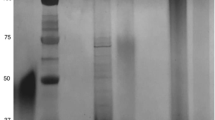Abstract
Lipids extracted fromHelicobacter pylori were separated into lipid classes by thin-layer chromatography. SimpleH. pylori lipids consisted of cholesterol esters, triglycerides, free fatty acids, cholesterol, diacylglycerols, and monoacylglycerols. Fatty acids were released from each lipid class by acid methanolysis, and analyzed by gas liquid chromatography and mass spectrometry. Unique methoxy fatty acids, including 11-methoxy heptadecanoic and 11-methoxy nonadecanoic acids, were the major components of the cholesterol esters and triglycerides. The predominance of methoxy fatty acids in the cholesterol esters ofH. pylori may contribute to the acid-resistant characteristic of this bacillus.
Similar content being viewed by others
References
Warren JR, Marshall B. Unidentified curved bacilli on gastric epithelium in active chronic gastritis. Lancet 1983;I:1273–1275.
Fox JG, Correa P, Taylor NS, et al.Campylobacter pylori-associated gastritis and immune response in a population at increased risk of gastric carcinoma. Am J Gastroenterol 1989; 84:775–781.
Correa P, Fox J, Fontham E, et al.Helicobacter pylori and gastric carcinoma. Cancer 1990;15:2569–2574.
Parsonnet J, Friedman GD, Vandersteen DP et al.Helicobacter pylori infection and the risk of gastric carcinoma. N Engl J Med 1991;325:1127–1131.
Burstein M, Monge E, Leon-Barua R, et al. Low peptic ulcer and high gastric cancer prevalence in a developing country with a high prevalence of infection byHelicobacter pylori. J Clin Gastroenterol 1991;13:154–156.
Goodwin CS, McCulloch JA, Armstrong A et al. Unusual cellular fatty acids and distinctive ultrastructure in a new spiral bacterium (Campylobacter pyloridis) from the human gastric mucosa. J Med Microbiol 1985;19:257–267.
Wait R, Hudson MJ. The use of picolinyl esters for the characterization of microbial lipids: Application to the unsaturated and cyclopropane fatty acids ofCampylobacter species. Lett Appl Microbiol 1985;1:95–99.
Lambert MA, Patton CM, Barrett TJ, et al. Differentiation ofCampylobacter andCampylobacter-like organisms by cellular fatty acid composition. J Clin Microbiol 1987;25:706–713.
Thompson LM, Smibert RM, Johnson JL, et al. Phylogenetic study of the genusCampylobacter. Int J Syst Bacteriol 1988;38:190–200.
Goodwin CS, McConnell W, McCulloch RK et al. Cellular fatty acid composition ofCampylobacter pylori from primates and ferrets compared with those of other Campylobacters. J Clin Microbiol 1989;27:938–943.
Inamoto Y, Hamanaka S, Hamanaka Y, et al. Unique fatty acids ofHelicobacter pylori are methoxy fatty acids. Proc Jpn Acad Ser B 1993;69:65–69.
Inamoto Y, Ariyama S, Hamanaka Y, et al. Lipid analysis ofHelicobacter pylori. J Clin Gastroenterol 1993;17(Suppl 1):s136-s139.
Validation of the publication of new names and new combinations previously effectively published outside the IJSB. Int J Syst Bact 1985;35:223–225.
Marshall BJ, Goodwin CS. Revised nomenclature ofCampylobacter pyloridis. Int J Syst Bact 1985;37:68.
François C, Marshall RD, Neuberger A. Carbohydrates in protein. 4. The determination of mannose, in hen's-egg albumin by radioisotope dilution. Biochem J 1962;83:335–341.
Aderem AA, Keum MM, Pure E, et al. Bacterial lipopolysaccharides, phorbol myristate, and zymogen induce the myristoylation of specific macrophage proteins. Proc Natl Acad Sci USA 1986;83:5817–5821.
Geis G, Leying H, Suerbaum S, et al. Unusual fatty acid substitution in lipids and lipopolysaccharides ofHelicobacter pylori. J Clin Microbiol 1990;28:930–932.
Author information
Authors and Affiliations
Rights and permissions
About this article
Cite this article
Inamoto, Y., Hamanaka, S., Hamanaka, Y. et al. Lipid composition and fatty acid analysis ofHelicobacter pylori . J Gastroenterol 30, 315–318 (1995). https://doi.org/10.1007/BF02347505
Received:
Accepted:
Issue Date:
DOI: https://doi.org/10.1007/BF02347505




